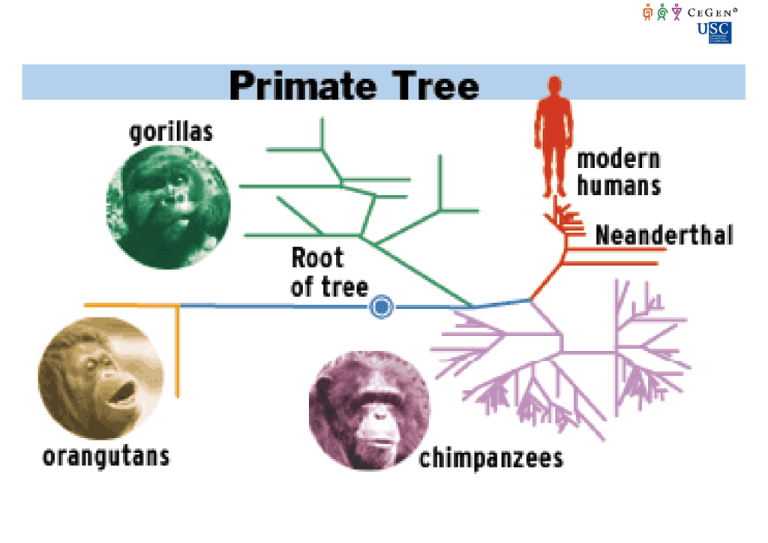Why is genetic variation important?
Anuncio

How does genetic structure change? changes h in allele frequencies and/or ll l f d/ genotype frequencies ge o ype eque c es through time oug e • mutation • migration g • natural selection natural selection • genetic drift genetic drift • non non‐random random mating mating POLIMORPHISM (VARIATION) Genetic variation in space and time Why is genetic variation important? Why is genetic variation important? potential for change in genetic structure potential for change in genetic structure • adaptation to environmental change adaptation to environmental change ‐ conservation •divergence of populations ‐ biodiversity bi di it Why is genetic variation important? variation no variation Why is genetic variation important? divergence variation no variation NO DIVERGENCE!! NO DIVERGENCE!! Natural selection can cause populations to diverge populations to diverge divergence Why is genetic variation important? variation global warming survival EXTINCTION!! no variation Uniparental markers: Y‐chromosome and mtDNA Y Adam and mtDNA Eve MRCA 1 2 4 5 6 7 8 generation ns 3 Allan Wilson, Wilson Mark Stoneking y Rebecca Cann de la Universidad de California (Can y cols., 1.987) publican en Nature la hipótesis popularizada posteriormente como la “Eva mitocondrial”. GRADO DE DIVERSIDAD GÉNICA É RECONSTRUCCIÓN GENEALÓGICA: RAÍZ EN EL CONTINENTE AFRICANO La figura muestra el árbol que se utilizó para inferir el origen africano de Eva Uniparental markers: Y‐chromosome and mtDNA Y‐chromosome phylogeny mtDNA phylogeny “O t f Af i ” “Out of Africa” Groupings based on Guthrie, 1948 Africa is home to the world’s largest language phylum, Niger‐Congo, language phylum, Niger Congo, with with 1,489 languages (the next largest being Austronesian) 750 million in Africa‐400 million Africans speak Niger‐Congo, 240 million have a Bantu language Bantu language 1/3 africans speak a bantu language as their native language .‐ nearest neighbours of Bantu languages within Niger‐Congo .‐ the highest diversity within the Bantu the highest diversity within the Bantu family itself are found in east Nigeria and west Cameroon west Cameroon both suggest that this may have been the ‘core’ area of the Bantu dispersal Hypothesis supported by linguistic evidence Khoisan (languages isolates in E Africa) (languages isolates in E Africa) Bantu migration into South Bantu migration into South Africa began in the 3rd century AD with the occupation of the fertile eastern and coastal stretches of the country, where they came into contact with the Khoikhoi The name Khokhoi means 'men of men'. They spread out across Southern Africa, and Southern Africa, and migrating south 2,000 years ago brought pastoralism (animal pastoralism (animal herding) Clicks in Bantu Ls Clicks in Bantu Ls Khoisan Ls The San lived by hunting y g and gathering in small nomadic 'bands' (pushed to the desert areas by to the desert areas by Khoikhoi pushed down by bantu expansion) Bantu farmers adopted invented a type of grain that grows in winter as opposite to the yp Mediterrenean type of agriculture. Later on they developped new developped new technologies which would give them clear advantages during the advantages during the expansion: .‐ iron making .‐ growing of domesticated bananas and plantains (north‐ eastern corner of equatorial rain forest) BANTU EXPANSION RETROCESO DE LOS PUEBLOS KHOISÁNIDOS Bantu migrations are believed to be one of the largest in the to be one of the largest in the history BANTU DISPERSAL-S D E L Can genetics help? Is this a true story? Proto-Bantu Proto Bantu origins Di Dispersals l themselves h l Numbers of people involved in the process What happen to the populations leaving in the area? L1 Includes MRCA (~ 150,000y) L1a L1 20-25% E,C,SE 2% W <1% 1% N, N S East origin likely Freq. in pigmy Presence in ST,Bi ST Bi E-CE-SE Founder types yp (y (years)) L1a1a: 1,900 (s.e. 750) L1a2: 800 (s.e. 550) Consistent with the formation of east Bantu communities in the Lake Victoria region around the last century BC and the first few centuries AD (Phillipson 1993) Yao Makonde Nyanja Makhwa Nguni Chwabo Nyungwue y g Lomwe Sena Shona Ndau Shangaan Tswa No se puede mostrar la imagen. Puede que su equipo no tenga suficiente memoria para abrir la imagen o que ésta esté dañada. Reinicie el equipo y , a continuación, abra el archiv o de nuev o. Si sigue apareciendo la x roja, puede que tenga que borrar la imagen e insertarla de nuev o. Tonga Chopi Ronga mtDNA and Bantu dispersals Two different components Ancestral types carried by the people living in the region before the arrival of Bantu speakers (Khoisan lineages, lineages L1d) 6% of the total lineages in the Bantu speakers: .- assimilation on arrival .- subsequent gene flow (there are not strong founder effects) Types brought with the Bantu speakers themselves .- 2/4 west Africa (4.000 y.a.) .- 1/4 east Africa (2.000 y.a.) .- 1/5 central or west central Africa 20% 24% 50% 6% Bantu expansion Khoisan contribution is higher in female component 6% mtDNA lineages , g 0,3% Y chr lineages Higher drift on the male than on the female line during the Bantu dispersals Higher levels of assimilation on the female side Larger female efective population size in the dispersing groups Lack of Khoisan lineages in Angola, point to a basically Bantu substrate of the extant Angolan g gene g pool. p Thus, the Bantu expansion was clearly more demic (in the sense of p population p replacement) p ) in the southwest than in the southeast, where remanents of ancient settlers (related to extant Khoisan) are evident Insights into the western Bantu dispersal: mtDNA lineage analysis in Angola. Plaza S, Salas A et al.. Hum Genet. 2004 Oct;115(5):439‐47 L1a (L1a1 and L1a2) L2a (L2a1a, L2a1b) L3e and d sublineages bl L3d and sublineages L1d (L1d1, L1d2) The Sahel runs 2,400 miles (3862 km) from the Atlantic Ocean in the west to the Red Sea in the east, in a belt that varies from several hundred to a thousand kilometers (620 miles) in width covering an area of 3 053 200 thousand kilometers (620 miles) in width, covering an area of 3,053,200 square kilometers (1,178,800 square miles). It is a transitional ecoregion of semi‐arid grasslands, savannas, and thorn shrublands lying between the wooded Sudanian savanna to the south and the Sahara wooded Sudanian savanna to the south and the Sahara to the north. to the north [1] The The countries of the Sahel today include Senegal, Mauritania, Mali, Burkina Faso, Niger, Nigeria, Chad, Sudan, and Eritrea. Históricamente es la cuna de algunos los Grandes Imperios Hi tó i t l d l l G d I i medievales africanos como el Imperio de Ghana y el Imperio de Malí, que se beneficiaron de la privilegiada posición de intermediarios en el comercio entre el área de Guinea y el norte de África. Cultivos de gramíneas y fibras, así como la ganadería y el comercio del oro yy la sal son las economías tradicionales. El límite norte del Sahel, siguiendo la isoyeta media de 150 mm de lluvia, en el período 1931 ‐ 1960, que cruza el continente africano de este a oeste se encuentra entre 50 y 100 km más al norte que de este a oeste, se encuentra entre 50 y 100 km más al norte que la misma isoyeta en el período 1968 ‐ 1997. Ciudades importantes en esta franja que ha quedado más seca: Nuakchott, en Mauritania; Agadez en Níger; Jartum en Sudán Mauritania; Agadez, en Níger; Jartum, en Sudán. The first instances of domestication of plants for agricultural purposes in Africa occurred in the Sahel region circa 5000 BCE, when sorghum and Af i African Rice Ri (Oryza glaberrima) (O l b i ) began to be cultivated. Around this time, b b li d A d hi i and in the same region, the small Guineafowl were domesticated. Around 4000 BCE the climate of the Sahara and the Sahel started to become drier at an exceedingly fast pace. This climate change caused lakes and rivers to shrink rather significantly and caused increasing , , desertification. This, in turn, decreased the amount of land conducive to settlements and helped to cause migrations of farming communities to the more humid climate of West Africa.[4] L1a (L1a1 and L1a2) L2a (L2a1a, L2a1b) L3e and d sublineages bl L3d and sublineages L1d (L1d1, L1d2) Western Mediterranean populations: Conclusions 3) No differences between Berber and Arab samples Arabisation in the Maghreb (7th and 11th C A D ): Arabisation in the Maghreb (7th and 11th C A.D.): Cultural replacement with little demographic impact Cultural replacement with little demographic impact 2) Sub‐Saharan flow detected in some NW African samples Continuous gene flow through the Sahara desert South‐north gradient of sub‐Saharan admixture Western Mediterranean populations: Conclusions 1) Clear genetic difference between NW Africa and SW Europe The Palaeolithic and Neolithic may have run in parallel along the two shores Gibraltar Straits may have acted as a geographical barrier Impact in Iberia of Arab occupation?? Impact in Iberia of Arab occupation?? Northern Europe was gradually recolonized from refugia ( ), , after the Last Glacial Maximum (LGM), 20,000 A A possible scheme of possible scheme of years ago (Housley et al. 1997). The two major refugia population movements since Paleolithic were in southwestern France/Cantabria (Atlantic and western Mediterranean zone) and Ukraine/Central western Mediterranean zone) and Ukraine/Central Russian Plain (Periglacial zone), but other minor refugia could have existed in between (Dolukhanov 2000). 18 000 BP 18,000 10,000 BP 45,000 BP 10,000 BP




